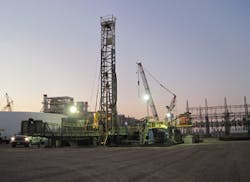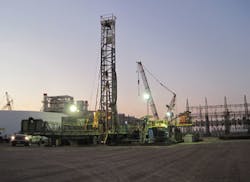Case Study: Deep-Well Injection Helps Solve Selenium Mitigation Concerns
By Edward McCullers, Lisa Culbert and Matt Bokor
Embraced by numerous industries and municipal utilities as an environmentally safe and cost-effective disposal option for liquid wastes, deep-well injection technology has been installed at a Southern California utility to resolve environmental concerns over its discharge of spent cooling-tower water.
The El Centro Generating Station (ECGS), part of the Imperial Irrigation District (IID) near the Mexican border, discharges brine waste from its cooling towers into the 376-square-mile Salton Sea, California's largest inland body of water.
Testing showed that the water exceeded the Maximum Contaminant Level (MCL) for selenium, which aquatic plants and invertebrates absorb. Bioaccumulation of this naturally occurring trace element has been linked to severe impacts in fish and aquatic birds.
Meanwhile, restoration of the Salton Sea -- a highly saline, below sea-level lake in California's Colorado Desert -- has become a growing priority. With minimal rain, 90% of the lake's inflow is nutrient-rich agricultural runoff from the Imperial, Coachella and Mexicali Valleys.
A consultant evaluated several options, including RO treatment with evaporation ponds for the waste stream. Additionally, IID personnel learned that nearby geothermal energy plants had a long, successful history with underground injection technology.
The utility issued an RFP and Layne Christensen Co., which has nationwide experience with Underground Injection Control (UIC) technology, was awarded the project.
"Although other options offered a lower capital cost, we were not confident that they would offer us a long-term solution," said Henryk Olstowski, IID Assistant Manager for Energy. "Sinking the deep injection wells was considered a calculated risk because you don't know if the well is going to comply with the permit until you've drilled it. But we were confident that this option provided us with the lowest lifecycle cost and, more importantly, a long-term solution to mitigating the selenium."
According to the U.S. Environmental Protection Agency, UIC technology provides industrial and municipal operations with an option that safely removes wastes from the surface environment by isolating them far beneath the land surface and away from drinking water resources. The geology must be suitable for UIC to be considered.
The history of deep injection traces to the 1930s, when oil companies began disposing of oil field brines and other waste products into depleted reservoirs. Today, according to USEPA, there are over 550 Class I deep wells in the United States. There are six classes of UIC wells regulated by USEPA.
Characterized by wide diameters with multiple casings, Class I wells are specifically designed to protect underground drinking water sources. Such wells are used nationally by food production, chemical, refining and pharmaceutical industries to discharge non-hazardous liquid waste streams. Numerous municipal utilities in Florida rely on deep injection wells to discharge treated wastewater.
"Deep injection technology serves a diverse cross section of American industry," said Edward McCullers, Layne Christensen's General Manager of Injection Well Operations. "For several decades, deep injection wells primarily served water utilities in Florida and chemical-industrial concerns in the Midwest. In recent years, large-scale water users, including several power companies, have been increasingly turning to UIC technology for discharge of blow-down water from cooling units."
For IID, the rigorous permitting process spanned two years, during which time injection formation tests had to prove specific porosity, permeability, static formation pressure, and effective thickness of the injection zone, a formation of sands and fine gravel more than 2,000 feet below land surface. Additional tests had to confirm the receiving zone was below the lowermost Underground Source of Drinking Water (USDW). The USDW is characterized as containing Total Dissolved Solids (TDS) of 10,000 ppl or less (as defined in 40 CFR §§144.3 and 146.3).
After working with a consultant for two years, IID received the UIC permit from USEPA Region IV for the El Centro Generating Station.
"The well development was very tricky," said Doug Watson, Project Manager for Layne Christensen.
While drilling exploratory wells, for example, crews had to block and seal off formations, then demonstrate that they had located the injection zone below the lowermost USDW and that the injection zone met all the permeability characteristics that were required, Watson said. Performance tests were conducted to define the flow and pressure that the IID will be held to under the operating permit.
"At times we were concerned whether or not the wells would comply with the permit requirements, but Layne did a great job working with us, our consultant and the EPA," Olstowski said. "In fact, the daily communication with the EPA for this project was the most intensive oversight I've ever experienced on a project. But at the end of the day, the EPA seemed extremely satisfied with Layne and all the parties involved."
Layne recently completed turnkey construction of two deep injection wells (2,200 and 2,700 feet in depth) capable of discharging a maximum of 850 gallons per minute (gpm). After completion of above-ground systems from the generating station to the well field, IID hopes to begin injection in early 2013.
About the Authors: Edward McCullers is General Manager, Injection Wells, Water Resources, at Layne Christensen Co. Lisa Culbert is Marketing Manager at Layne and may be contacted at [email protected]. Matt Bokor is a consultant for Layne Christensen. He may be contacted at [email protected].

